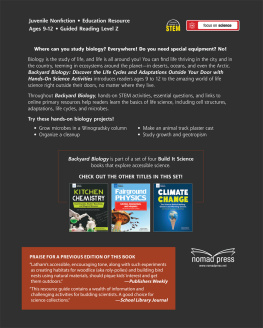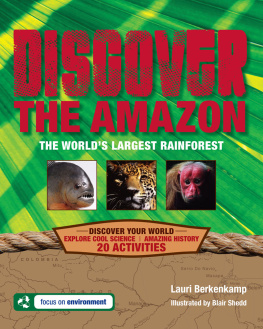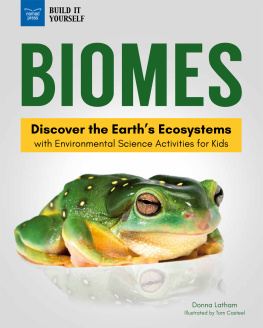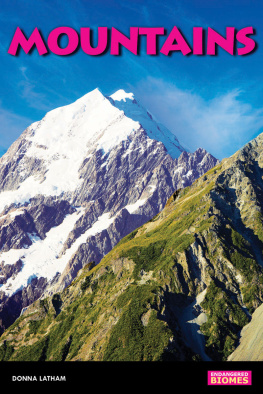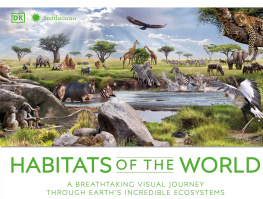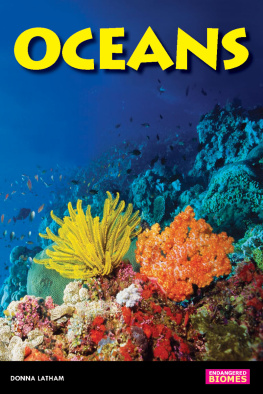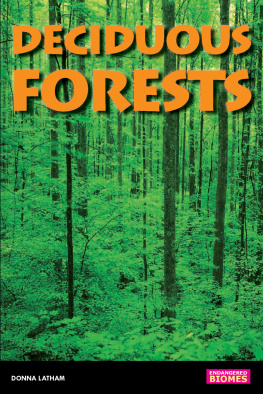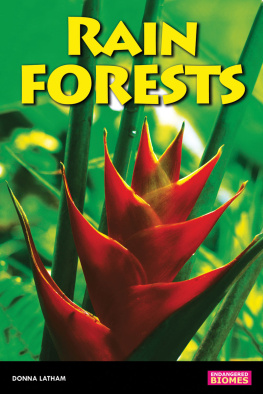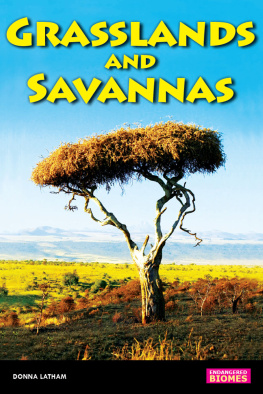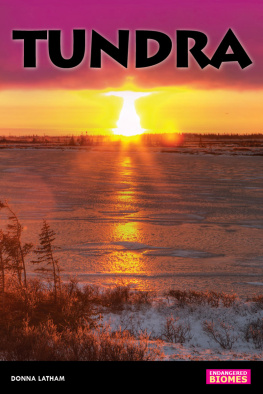All rights reserved.
No part of this book may be reproduced in any form without permission in writing from the publisher, except by a reviewer who may quote brief passages in a review. The trademark Nomad Press and the Nomad Press logo are trademarks of Nomad Communications, Inc.
Questions regarding the ordering of this book should be addressed to Independent Publishers
Group 814 N. Franklin St.
2456 Christian St.
Grab your backpack! Youre about to embark on an exciting expedition to explore one of Earths major biomes: the coniferous forest!
Did You Know
Scientists dont agree on how many biomes there are. Some divide the earth into five biomes. Others argue for 12.
Words to Know
biome: a large natural area with a distinctive climate, geology, and set of water resources. A biomes plants and animals are adapted for life there.
coniferous forest: a northern forest of trees.
climate: average weather patterns in an area over many years.
geology: the rocks, minerals, and physical structure of an area.
adapt: changes a plant or animal makes to survive in new or different conditions.
ecosystem: a community of living and nonliving things and their environment. Living things are plants, animals, and insects. Nonliving things are soil, rocks, and water.
environment: everything in nature, living and nonliving.
Each biome has its own biodiversity, which is the range of living things adapted for life there. It also contains many ecosystems. In an ecosystem, living. and nonliving things interact with their environment.
Teamwork keeps the system balanced and working. Earths biomes are connected together, creating a vast web of life.
Landscape and Climate of the Coniferous Forest
The coniferous forest is a vast band of trees that circles parts of Asia, Canada, Europe, Russia, and the United States. Coniferous trees, which dont shed their leaves each year, define the largest land biome on earth.

here: The coniferous forest climate: has only two seasons. Long, dry winters are cold. Short, wet summers are cool.
there: The deciduous forest climate enjoys four distinct seasons. These are spring, summer, fall, and winter.
Its like a gigantic green wreath around the Northern Hemisphere. At its southern edge, the coniferous forest mingles with deciduous forests. To the north, it merges with the treeless Arctic tundra.
Word exploration
Conifer comes from the Latin word conus, which means cone, and ferre, to bear.
Words to Know
coniferous: describes trees and bushes that produce their seeds in cones. Many coniferous trees have needles for leaves.
Northern Hemisphere: the half of the earth north of the equator.
deciduous: describes trees and bushes that shed their leaves each year.
There are two types of coniferous forests. Trees in closed-canopy forests grow tightly together. They shade the mossy carpet of the forest floor. Trees in open-canopy forests are scattered and widely spaced. Instead of velvety mosses, gray-green lichen sprawl over the ground.

Winters are long and bitterly cold. Temperatures plunge to -40 decrees Fahrenheit or colder (-40 decrees Celsius).
Words to Know
lichen: patchy plants that grow on rocks, trees, and other surfaces.
precipitation: any falling moisture, such as rain or snow.
decompose: to break down or rot.
humus: decaying matter made from dead plants and animals. Humus supplies soil with nutrients and helps soil retain water.
nutrients: substances that living things need to live and grow.
Summers only get as high as 70 degrees Fahrenheit (21 degrees Celsius). A brief growing season of three to four months sneaks in during the warmer, wetter months. Total precipitation in a year is 12 to 33 inches (30 to 85 centimeters).
Because of cool temperatures, dead plants and animals decompose slowly. This means that the soil has little humus, so it is low in nutrients for plants.
Lakes and swampy areas such as marshes and bogs cut through the coniferous forests. These wet places are perfect homes for millions and millions of insects.
Plants Growing in the Coniferous Forest Have Adapted
Conifers are cone-bearing trees. Cones hold seeds and scaly needles. Many conifers, also called evergreens, remain green all year round. Evergreens that thrive in the coniferous forest include cedar, cypress, fir, pine, and spruce. Hardy deciduous trees, such as aspen, poplar, and birch, squeeze in here and there.
How do conifers adapt to survive long, dry winters?
Deep, dark-green coloring helps evergreens capture lots of the suns light for photosynthesis. A waxy coating on their needles protects them from drying out in winter winds.

Words to Know
evergreen: a tree that keeps its leaves or needles throughout the year.
photosynthesis:
the process through which plants create food, using light as a source of energy.

Did You Know?
Youll find some deciduous trees in the coniferous forest and some coniferous trees in the deciduous forest. But mostly conifers live in the coniferous forest. Mostly deciduous trees live in the deciduous forest.



